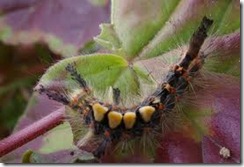 The first sign of a moth worm problem is often when geranium buds fail to open completely, resulting in distorted flower clusters. The culprit is often the caterpillar of the tobacco (or geranium) budworm, a serious pest of geraniums, nicotiana and petunias in gardens. Zonal geraniums seem more prone to attack than ivy leaf varieties.
The first sign of a moth worm problem is often when geranium buds fail to open completely, resulting in distorted flower clusters. The culprit is often the caterpillar of the tobacco (or geranium) budworm, a serious pest of geraniums, nicotiana and petunias in gardens. Zonal geraniums seem more prone to attack than ivy leaf varieties.
The Problem
-
Within the United States, the tobacco budworm is a major pest in agriculture, particularly with cotton and tobacco growers. It costs the industry millions of dollars annually to control. Budworm pupa overwinter in the soil, and are resistant to many common insecticides.
Life History
-
The greenish-brown moth has a wingspan of about 1 1/2 inches. Females lay eggs on leaves or buds. Larvae hatch and burrow into the buds, eating as they go. They often take on the color of the flowers, making them harder to spot. Fully grown in about a month, they fall to the soil and pupate. Adult moths emerge and the cycle begins again, continuing until day length shortens and temperatures fall, when hibernation takes place.
Control
-
The most effective form of control if plant numbers are small is to pick off the caterpillars by hand. They are most easily spotted at dusk when most active. For chemical control, use synthetic pyrethroid insecticides. Natural pyrethrins, and biological controls containing Bacillus thuringiensis have not proved effective against budworm on geraniums.

Deprecated: strpos(): Passing null to parameter #1 ($haystack) of type string is deprecated in /home/agriviek8Qv/agriviet.net/public_html/wp-includes/comment-template.php on line 2522